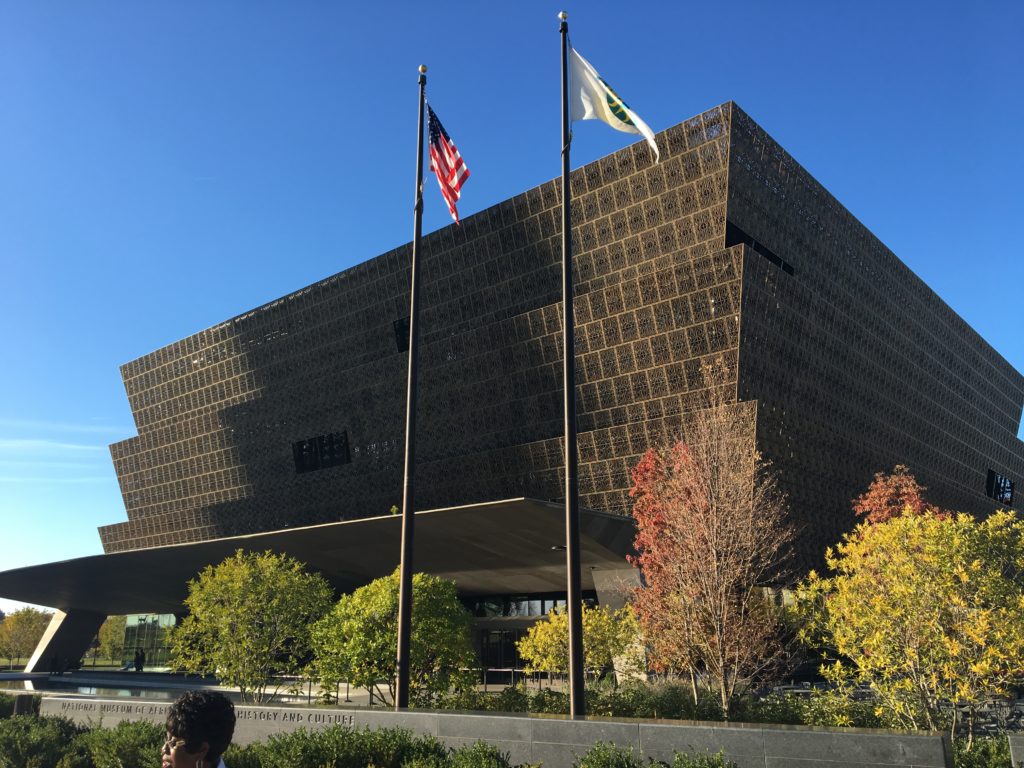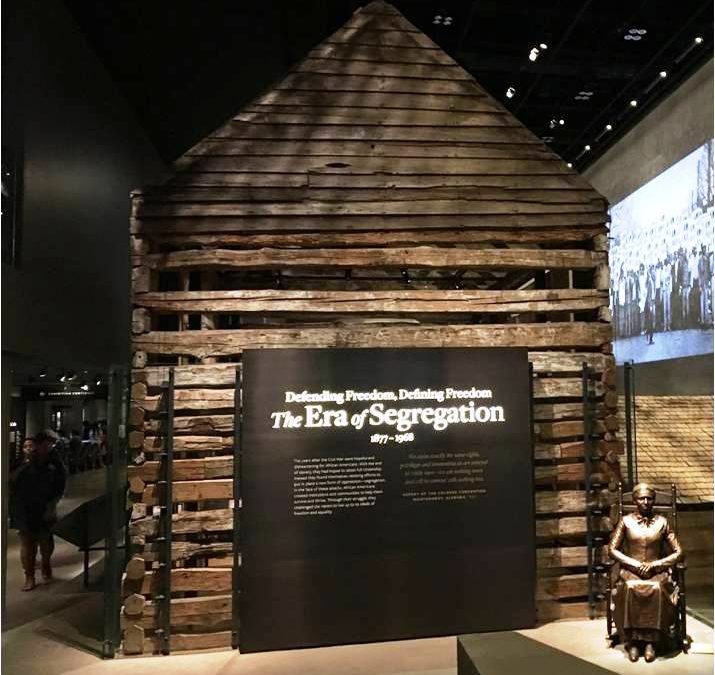The National Museum of African American History and Culture works to expand its interpretation of the Freedom House
September 2018
The purpose of this latest project of the Smithsonian NMAAHC is to more fully document the history of the Jones-Hall-Sims “Freedom House” and the life of the community around it through a series of oral histories.
Built circa 1874 by Richard Jones, a former slave, the two-story log structure was located in the historic Jonesville community in Maryland. The home, which was stripped of 140 years of additions and siding, was acquired in 2009 by the NMAAHC and has been reassembled as part of its exhibition on the Era of Segregation. It is a rare surviving example of post-Emancipation homes that were constructed in newly established free black communities.
Oral history subjects include a former resident of the house who spent her childhood there, people from the community, NMAAHC curators, the construction contractor, and myself. I was chosen because I conducted extensive field work in Maryland in 1979 and one of the houses that I documented back then was the Jones-Hall-Sims house.
During the planning stage, our oral-history production team, including oral historian Kelli Navies, videographer Trudy Hutchinson, intern Paris Young, and me, thought about the importance of what houses like this can tell us; from there we developed a series of questions, unique to each participant’s relationship with the Freedom House, that would help the public to better understand the house, its history, and its community context.
Following is a behind-the-scenes look at a selection of the interview questions; we realized at the time that these were simply to get the wheels turning, because as typically happens, other questions and directions would present themselves during the course of the live interviews. We hope you’ll enjoy hearing the results of our efforts when you visit the museum next year, but before then, what questions would you have asked the participants? And, if it could talk, what stories would you like to hear from the Freedom House? I invite your comments below.
Kerry Shackelford, Museum Resources
Kerry’s company handles historical building restoration, renovation and, in the case of the Freedom House, disassembly and reassembly. Kerry participated in the oral histories and questions to him included: How did you get involved with the Jones-Hall-Sims House? What did you learn about the house as you dismantled it? Was there anything distinctive about this house that would have told a researcher that it was an African American home? Or that it was built in Maryland instead of Virginia or elsewhere? If the house could talk, what questions would you ask?

With me is Kerry Shackelford, left, with Museum Resources; his company handled the disassembly and reassembly of the Freedom House; at center is Kelli Navies, oral historian.
Paul Gardullo, Smithsonian Curator, and Spencer Crew, Historian and Smithsonian Guest Curator
Key participants in the oral histories, Paul and Spencer were asked similar questions, including: What were the governing ideas for the Era of Segregation Exhibit? Why choose a house as the first artifact that one sees? What led you to choose this particular house? What were the interpretive goals for the house? What messages do you want visitors to leave with? If the house could talk, what questions would you ask?

Paul Gardullo, center, with me and Kelli.

Spencer Crew, historian and guest curator of The Segregation Era exhibit at the Smithsonian’s NMAAHC. Photo credit: Washington Post
Chanell Kelton, former resident of the Jones-Hall-Sims Freedom House.
Chanell Kelton was born in 1984 and was reared in the Jones-Hall-Sims House. There were no shortage of questions for her, including: How long did you live there? What did the house and the landscape around the house — orchards, sheds, gardens, etc. — look like when you were growing up? What are your favorite memories of the home? What were your grandmother and grandfather like? What was the Jonesville community like? How did this home with your grandparents influence your life? Why is this house important?

Chanell Kelton, took her first steps in the Jones-Hall-Sims House.
Gwen Reese and Suzanne Johnson, community historians of Sugarland, Maryland, one of the hundreds of all-black towns and communities established by freed slaves after the Civil War. (No photo available)
Questions asked of them included: What did Sugarland mean to you growing up? What did Sugarland look like when you were young? Were there any connections to Jonesville through kin, friendship, or church? Your ancestors lived when segregation and racial prejudice were in full force in jobs, schools, voting rights, civil rights, etc. How do you think they dealt with them? How has Montgomery County changed since you were young? Why is this house from Jonesville important?
More of our production team:

Second from left: videographer Trudy Hutchinson with L-R: Kelli Navies, Chanell Kelton, and me.

L-R: Intern Paris Young from Washington College and me, Paul, and Trudy.

During this visit, while managing to dodge crowds on the plaza, I captured a pretty good shot of The Smithsonian National Museum of African American History and Culture, an imposing and inspiring structure, to say the least.
 George W. McDaniel, Ph.D., is President of McDaniel Consulting, LLC, a strategy firm that helps organizations use history to build bridges within itself and to its broader constituents. The company’s tag line, “Building Bridges through History,” is grounded in McDaniel’s personal beliefs and his experience in site management, preservation, education, board development, fundraising, and community outreach. Rather than using history to divide us, he strives to help organizations use history, especially local history, to enhance cross-cultural understanding and to support local museums, preservation, and education. Dr. McDaniel recently led volunteer efforts with Emanuel AME Church and historical organizations in Charleston to use historic preservation to enhance racial reconciliation and healing. McDaniel is also the Executive Director Emeritus of Drayton Hall, a historic site in Charleston, SC, owned by the National Trust for Historic Preservation.
George W. McDaniel, Ph.D., is President of McDaniel Consulting, LLC, a strategy firm that helps organizations use history to build bridges within itself and to its broader constituents. The company’s tag line, “Building Bridges through History,” is grounded in McDaniel’s personal beliefs and his experience in site management, preservation, education, board development, fundraising, and community outreach. Rather than using history to divide us, he strives to help organizations use history, especially local history, to enhance cross-cultural understanding and to support local museums, preservation, and education. Dr. McDaniel recently led volunteer efforts with Emanuel AME Church and historical organizations in Charleston to use historic preservation to enhance racial reconciliation and healing. McDaniel is also the Executive Director Emeritus of Drayton Hall, a historic site in Charleston, SC, owned by the National Trust for Historic Preservation.
A frequent writer, speaker, and facilitator about such issues, he can be reached at gmcdaniel4444@gmail.com or through his website at www.mcdanielconsulting.net.
Header Image: The 1874 Jones-Hall-Sims “Freedom House” from Maryland on exhibit at the Smithsonian’s National Museum of African American History and Culture in Washington D.C.
Images courtesy of the author unless otherwise noted.

 McDaniel Consulting LLC is a strategy firm that helps organizations use history to build bridges within itself and its broader constituents.
McDaniel Consulting LLC is a strategy firm that helps organizations use history to build bridges within itself and its broader constituents.